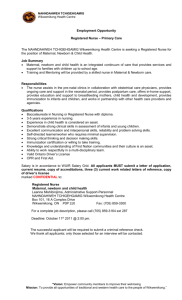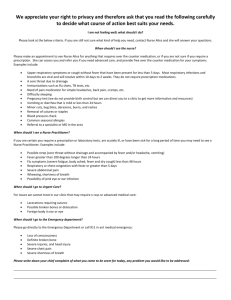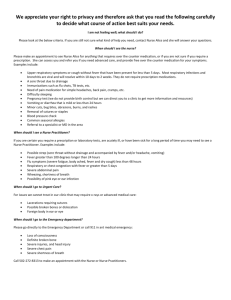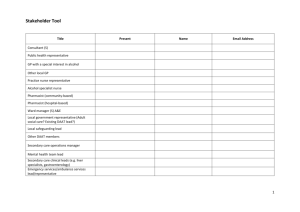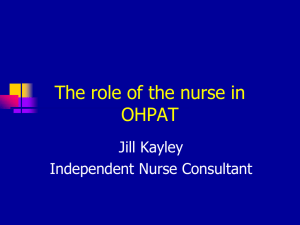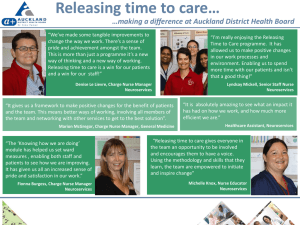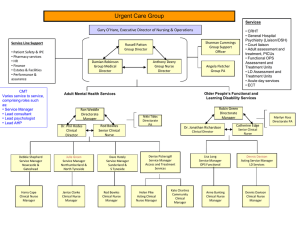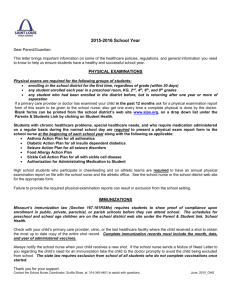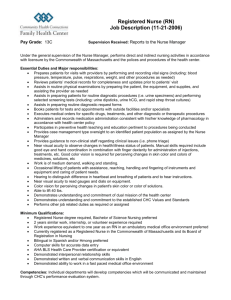Chapter 1 Key Terms The Past, Present, and Future Advocate
advertisement
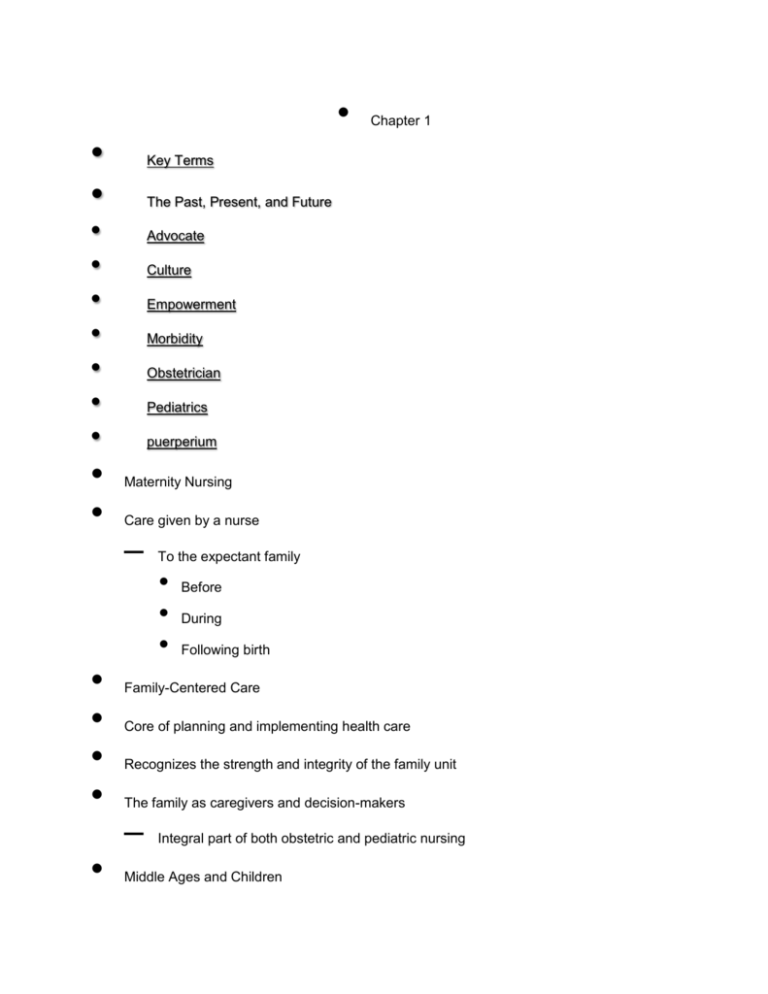
• • • Key Terms The Past, Present, and Future • • • • • • • • • • • • • • Chapter 1 Advocate Culture Empowerment Morbidity Obstetrician Pediatrics puerperium Maternity Nursing Care given by a nurse – To the expectant family • • • Before During Following birth Family-Centered Care Core of planning and implementing health care Recognizes the strength and integrity of the family unit The family as caregivers and decision-makers – Integral part of both obstetric and pediatric nursing Middle Ages and Children • • • • • • • • • • • • The concept of childhood did not exist Infancy lasted until around age 7 Had to assimilate into adult world Did not attend school 19th Century Discoveries Karl Credé (1819-1892) – Recommended instillation of silver nitrate into newborn’s eyes to prevent blindness from gonorrhea 19th Century Discoveries (cont.) Ignaz Semmelweis (1818-1865) – – Discovered relationship between puerperal fever and examinations by physicians and students fresh from the cadaver labs Found puerperal fever was a form of sepsis; was contagious and transmitted through unwashed hands 19th Century Discoveries (cont.) Louis Pasteur (1822-1895) – – Confirmed puerperal fever caused by bacteria Spread by improper handwashing and contact with contaminated objects Joseph Lister (1827-1912) – – Experimented with chemical means to prevent infection Revolutionized surgical practice • Introduced concept of antiseptic surgery The 1900s • • • • • • • • • • • • • • • • • Early in the century, the majority of births were in the home Hospitals began to develop training programs for nurses By the 1950s, hospital practice in obstetrics was well-established By 1960, more than 90% of births in the U.S. were in hospitals The Birth Process in the 1960s Fathers waited outside of the delivery room Mothers were placed in a “twilight sleep” and had little involvement in the delivery process The infant was kept from parents for hours after birth, which delayed the parent-infant bonding process Culture Strong influence on the standards of child care – – – Primitive tribes were nomads Strong survived and stayed with the tribe Weak were left behind to die As time progressed, children were valued more on what they could produce Today, as in the past, culture affects how a family perceives health and illness Family Medical Leave Act (FMLA) Became law in 1993 Allows for employees to take up to 12 weeks of unpaid leave to care for a newborn or family member Employee cannot lose benefits or pay status if they take FMLA HIPAA (cont.) – – • • • • • • • • • • • • • • • Health care personnel are expected to maintain strict confidentiality Regulations mandate that the names and personal information of patients be kept in a secure and private place The Children’s Bureau Established by Lillian Wald in 1912 Focused attention on problems of infant mortality Was followed by maternal mortality Led to birth registration in all states In the 1930s, led to development of hot lunch programs in the schools Fair Labor Standards Act of 1938 Established a general minimum working age – – 16 years for non-hazardous jobs 18 years for hazardous jobs White House Conferences First one in 1909, Theodore Roosevelt was president Continues to be held every 10 years 1930—Children’s Charter was established 1980—involved all states in an effort to see what problems families were facing in various parts of the country Public Health Department Responsible for disease prevention and control – Community • • • • • • • • • • – – Statewide Nationally Includes laws about licensing of health care providers (i.e., physicians and pharmacists) Public Health Department (cont.) Pure Food and Drug Act – Controls medicines, poisons, and the purity of food Programs include – – – – Disaster relief Care and rehabilitation of handicapped children Foster child care Protective services for abused or neglected children Reportable Situations Nurse has legal responsibility to report certain diseases or conditions to local public health authorities – An illness that poses a health hazard to the public Suspected child abuse or suicidal behavior must be reported immediately to protect the child from further harm The Present: Maternity Care Family involvement during pregnancy and birth – Necessary for bonding and support Three separate sections of the maternity unit – – Labor-delivery Postpartum • • • • • • • • – Newborn nursery Some facilities have merged all three areas into one Birthing Centers Provide comprehensive care – – – – – – Antepartum Labor-delivery Postpartum Mothers’ classes Lactation classes Follow-up family planning Midwives First school of nurse-midwifery – Opened in New York City, 1932 Certified Nurse-Midwife (CNM) – – – – – Registered nurse Graduate from an accredited midwife program National certification Provides comprehensive prenatal and postnatal care Attends uncomplicated deliveries Health Care Delivery Systems Cost-containment a driver for change • • • • • • • Diagnosis-related groups (DRGs): determine payment for a hospital stay based on the diagnosis Push for early discharge Established need for Nurse Case Managers and Utilization Review Nurses Documentation It is the LEGAL responsibility of the nurse Facilities differ on the type of charting methods – – Paper Computerized Regardless of method, if you did not document the care you provided, medicolegally, you did not do it!
